2015 MERCEDES-BENZ E-CLASS SALOON warning
[x] Cancel search: warningPage 419 of 497
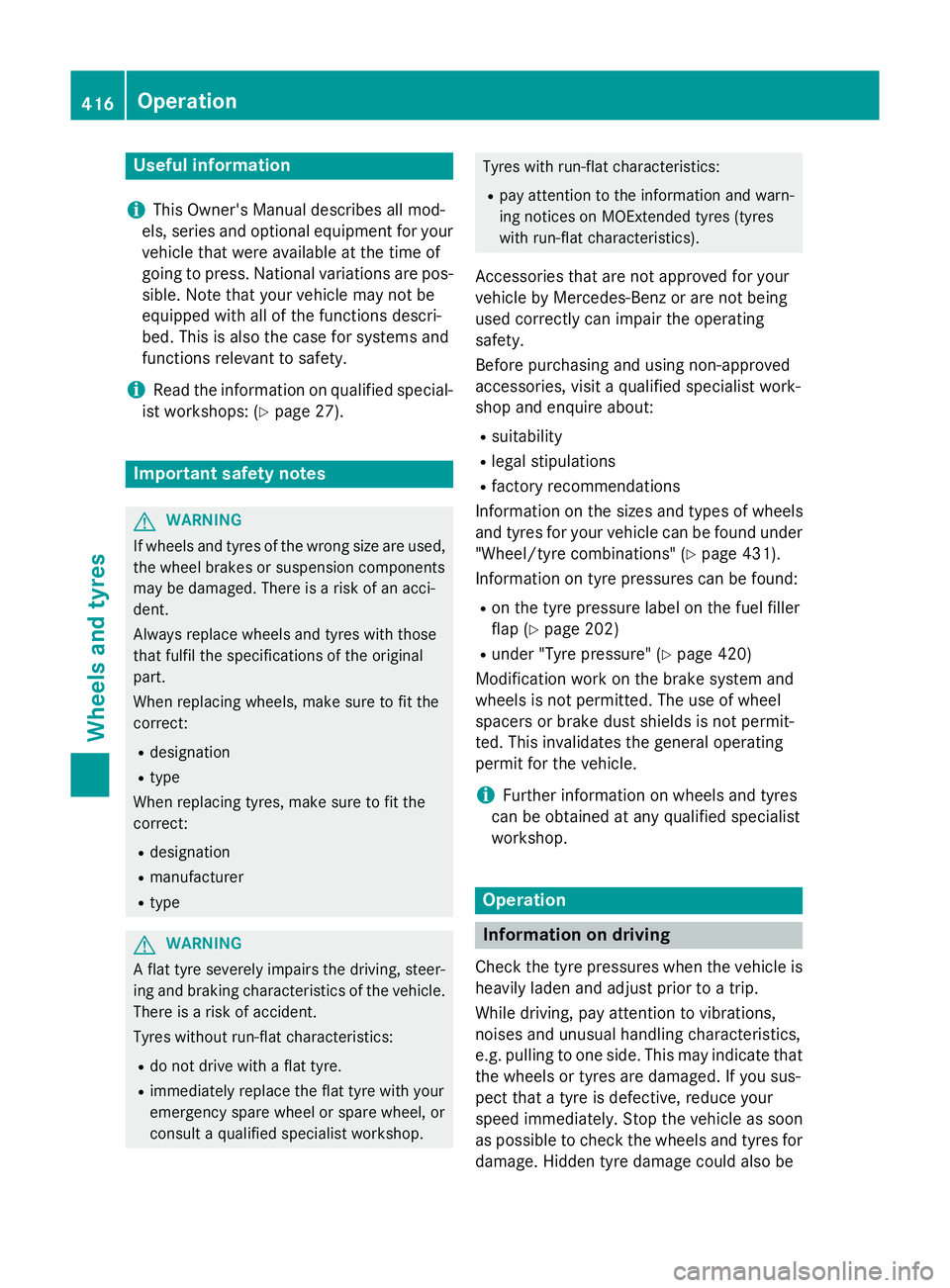
Useful information
i This Owner's Manual describes all mod-
els, series and optional equipment for your
vehicle that were available at the time of
going to press. National variation sare pos-
sible. Not ethat your vehicle may not be
equipped with all of the function sdescri-
bed. This is also the case for system sand
function srelevan ttosafety.
i Read the information on qualified special-
ist workshops: (Y page 27). Important safet
ynotes G
WARNING
If wheels and tyres of the wrong size are used, the wheel brakes or suspensio ncomponents
may be damaged. There is arisk of an acci-
dent.
Always replace wheels and tyres with those
that fulfil the specification softhe original
part.
When replacin gwheels, make sure to fit the
correct:
R designation
R type
When replacin gtyres, make sure to fit the
correct:
R designation
R manufacturer
R type G
WARNING
Af lat tyre severely impairs the driving, steer-
ing and brakin gcharacteristic softhe vehicle.
There is arisk of accident.
Tyres without run-flat characteristics:
R do not drive with aflat tyre.
R immediately replace the flat tyre with your
emergency spare wheel or spare wheel, or
consult aqualified specialist workshop. Tyres with run-flat characteristics:
R pay attention to the information and warn-
ing notices on MOExtended tyres (tyres
with run-flat characteristics).
Accessories that are not approved for your
vehicle by Mercedes-Benz or are not being
used correctly can impair the operating
safety.
Before purchasin gand using non-approved
accessories, visit aqualified specialist work-
shop and enquire about:
R suitability
R legal stipulations
R factory recommendations
Information on the sizes and types of wheels
and tyres for your vehicle can be found under
"Wheel/tyre combinations" (Y page 431).
Information on tyre pressures can be found:
R on the tyre pressure label on the fuel filler
flap (Y page 202)
R under "Tyre pressure" (Y page 420)
Modification work on the brake system and
wheels is not permitted. The use of wheel
spacers or brake dust shields is not permit-
ted. This invalidates the general operating
permit for the vehicle.
i Further information on wheels and tyres
can be obtained at any qualified specialist
workshop. Operation
Information on driving
Check the tyre pressures when the vehicle is
heavily laden and adjust prior to atrip.
While driving, pay attention to vibrations,
noises and unusual handling characteristics,
e.g. pulling to one side. This may indicat ethat
the wheels or tyres are damaged. If you sus-
pect that atyre is defective, reduce your
speed immediately. Stop the vehicle as soon
as possible to chec kthe wheels and tyres for
damage. Hidden tyre damage could also be 416
OperationWheels and tyres
Page 420 of 497
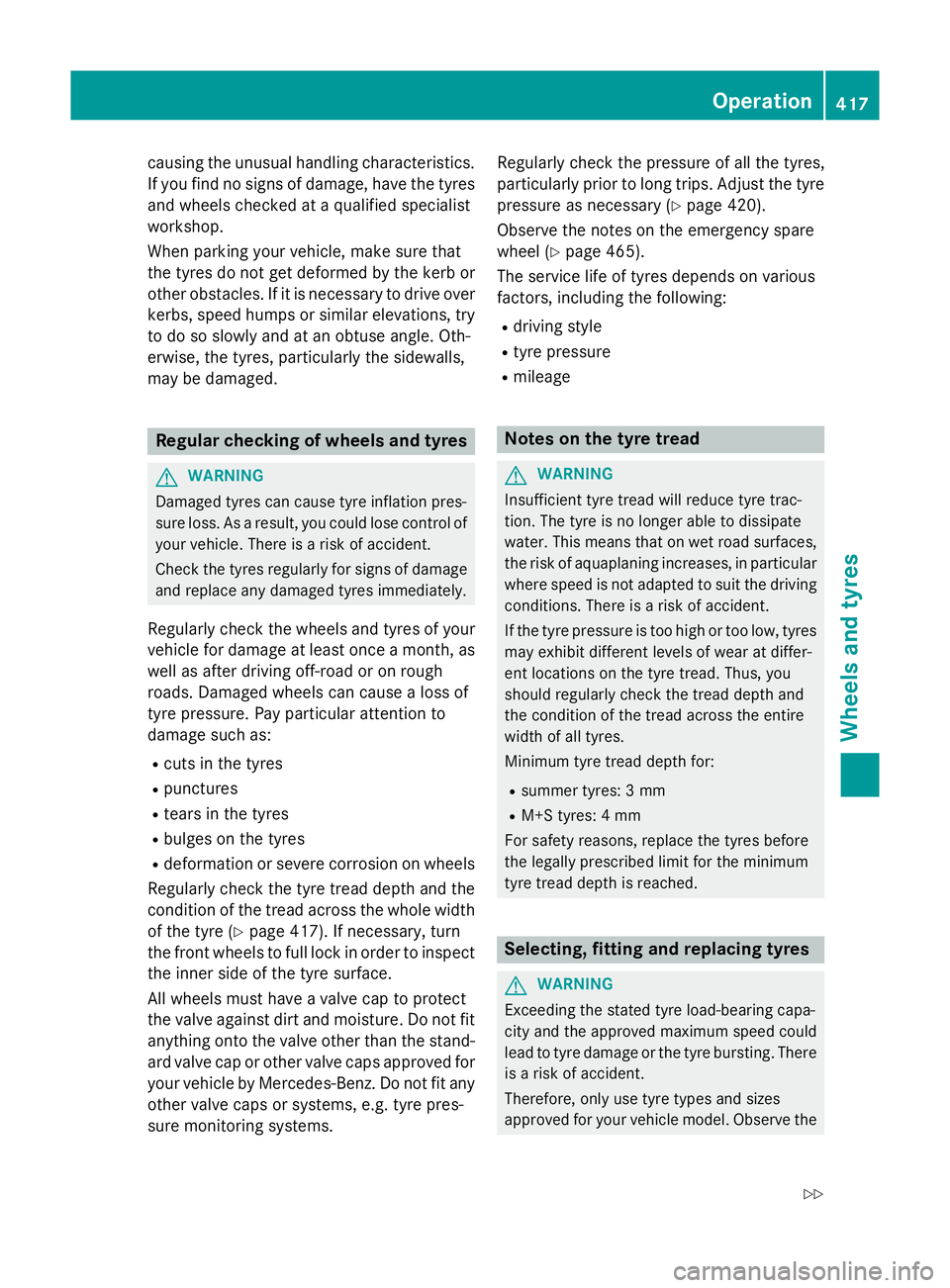
causing the unusual handling characteristics.
If yo ufind no signs of damage, have the tyres
and wheel schecke dataq ualified specialist
workshop.
Whe nparking your vehicle ,make sure that
the tyre sdonot get deforme dbythe kerb or
othe robstacles. If it is necessary to drive over
kerbs, speed humps or similar elevations ,try
to do so slowl yand at an obtuse angle .Oth-
erwise ,the tyres, particularly the sidewalls,
may be damaged. Regular checking of wheel
sand tyres G
WARNING
Damaged tyre scan cause tyre inflation pres-
sure loss. As aresult, yo ucould los econtrol of
your vehicle .There is ariskofa ccident.
Check the tyre sregularl yfor signs of damage
and replace any damaged tyre simmediately.
Regularly check the wheel sand tyre sofyour
vehicle for damag eatleastonce amonth, as
well as afte rdriving off-road or on rough
roads. Damaged wheel scan cause alossof
tyre pressure. Pa yparticula rattention to
damag esucha s:
R cuts in the tyres
R punctures
R tears in the tyres
R bulge sont he tyres
R deformation or severe corrosio nonwheels
Regularly check the tyre trea ddepth and the
condition of the trea dacross the whol ewidth
of the tyre (Y page 417). If necessary, turn
the front wheel stofullloc kino rder to inspect
the inner sid eofthe tyre surface.
All wheel smusth aveav alve cap to protect
the valve against dirt and moisture. Do not fit
anything onto the valve othe rthan the stand-
ard valve cap or othe rvalve cap sapproved for
your vehicle by Mercedes-Benz. Do not fit any othe rvalve cap sorsystems ,e.g. tyre pres-
sure monitoring systems. Regularly check the pressure of al
lthe tyres,
particularly prior to long trips. Adjust the tyre pressure as necessary (Y page 420).
Observe the notes on the emergency spare
wheel (Y page 465).
The service life of tyre sdepends on various
factors, including the following:
R driving style
R tyre pressure
R mileage Note
sont he tyre tread G
WARNING
Insufficient tyre trea dwillr educe tyre trac-
tion. The tyre is no longer able to dissipate
water. Thi smeans that on we troa ds urfaces,
the ris kofaquapl aning increases, in particular
where speed is not adapted to suit the driving
conditions .There is ariskofa ccident.
If the tyre pressure is too hig hortoo low ,tyres
may exhibi tdifferent level sofwearatd iffer-
ent locations on the tyre tread. Thus, you
shoul dregularl ycheck the trea ddepth and
the condition of the trea dacross the entire
width of al ltyres.
Minimum tyre trea ddepth for:
R summer tyres: 3mm
R M+S tyres: 4mm
For safety reasons, replace the tyre sbefore
the legall yprescribed limit for the minimum
tyre trea ddepth is reached. Selecting, fitting and replacing tyres
G
WARNING
Exceeding the state dtyre load-bearing capa-
city and the approved maximum speed could
lead to tyre damag eorthe tyre bursting .There
is ar iskofa ccident.
Therefore, only us etyre types and sizes
approved for your vehicle model .Observe the Operation
417Wheels and tyres
Z
Page 421 of 497
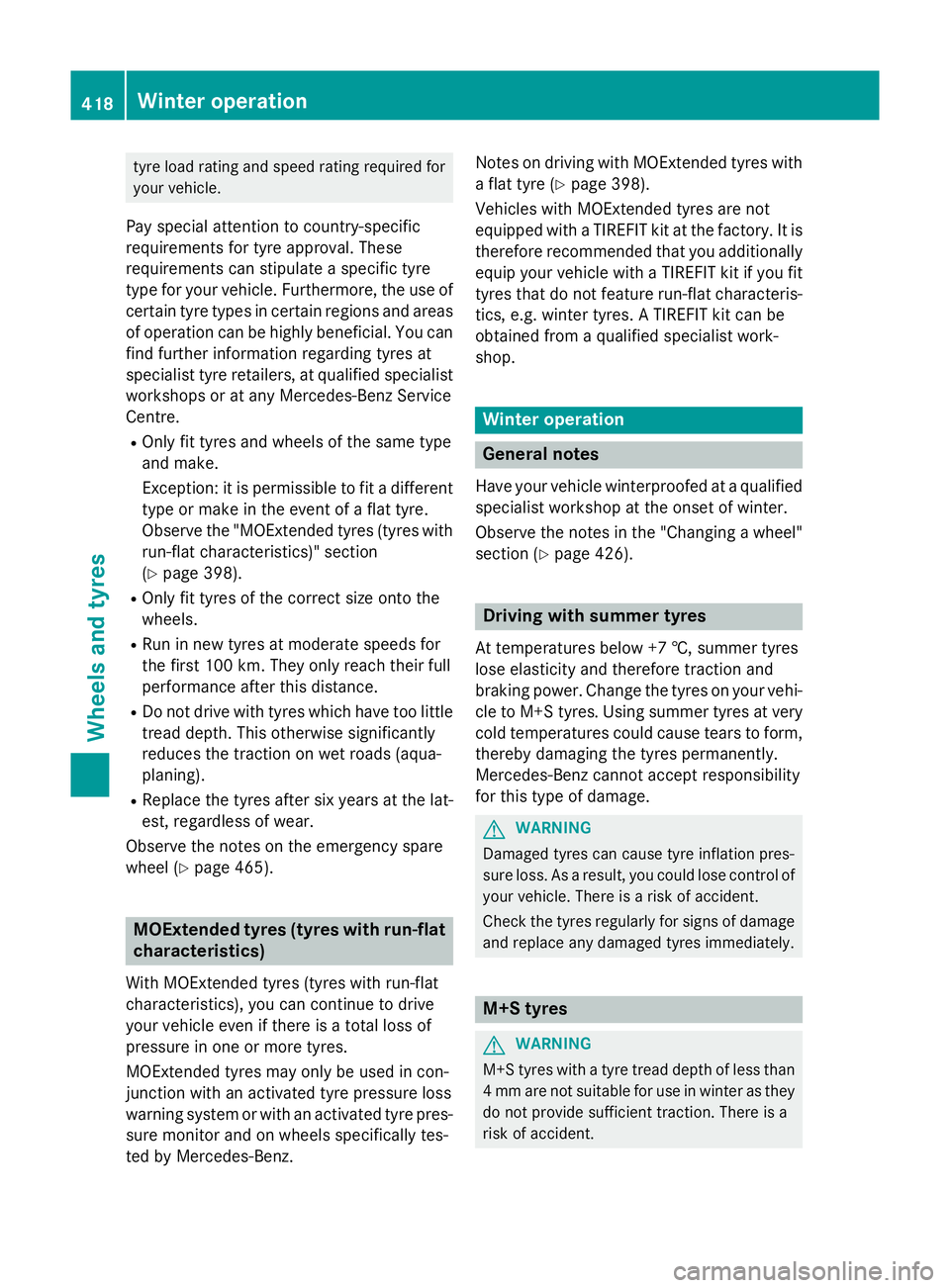
tyr
eloa dr ating and spee drating required for
your vehicle.
Pa ys pecial attentio ntocountry-specific
requirements for tyr eapproval. These
requirements can stipulate aspecific tyre
typ efor your vehicle. Furthermore, the us eof
certain tyr etypes in certain regions and areas
of operatio ncan be highl ybeneficial. Yo ucan
fin df urthe rinformation regarding tyres at
specialis ttyrer etailers ,atqualified specialist
workshop soratany Mercedes-Benz Service
Centre.
R Onl yfit tyres and wheels of the same type
and make.
Exception: it is permissibl etofitad ifferent
typ eorm akeint he event of aflatt yre.
Observe the "MOExtende dtyres (tyres with
run-flat characteristics) "section
(Y page 398).
R Onl yfit tyres of the correct size onto the
wheels.
R Ru ninn ew tyres at moderate speeds for
the first 100 km .The yo nlyr each their full
performance after thi sdistance.
R Do not drive with tyres which have too little
trea ddepth.T hiso therwis esignificantly
reduce sthe tractio nonwetroads (aqua-
planing).
R Replace the tyres after si xyears at the lat-
est, regardles sofwear.
Observe the note sonthe emergency spare
whee l(Y page 465). MOExtende
dtyre s(tyres with run-flat
characteristics)
With MOExtende dtyres (tyres with run-flat
characteristics) ,you can continue to drive
your vehicl eevenift here is atota llos sof
pressure in one or mor etyres.
MOExtende dtyres ma yonlybeu sedinc on-
junction with an activated tyr epressure loss
warning system or with an activated tyr epres-
sure monitor and on wheels specifically tes-
ted by Mercedes-Benz. Note
sond rivingwithM OExtende dtyres with
af latt yre( Ypage 398).
Vehicles with MOExtende dtyres ar enot
equipped with aTIREFIT kit at the factory .Itis
therefore recommende dthatyou additionally
equi pyourvehicl ewithaT IREFIT kit if yo ufit
tyres tha tdon ot featur erun-flat characteris-
tics ,e.g.w inter tyres .ATIREFIT kit can be
obtained fro maqualified specialis twork-
shop. Winter operation
General notes
Hav eyourvehicl ewinterproofed at aquali fied
specialis tworkshop at the onse tofwinter.
Observe the note sinthe "Changing awheel"
sectio n(Ypage 426). Driving with summe
rtyres
At temperatures belo w+7†,summertyres
lose elasticity and therefore tractio nand
braking power. Chang ethe tyres on your vehi-
cle to M+S tyres .Using summe rtyres at very
col dtemperatures could cause tears to form,
thereb ydamagin gthe tyres permanently.
Mercedes-Benz cannot accep tresponsibility
for thi stypeofd amage. G
WARNING
Damaged tyres can cause tyr einflatio npres-
sure loss. As aresult, yo ucould lose contro lof
your vehicle. There is ariskofa ccident.
Check the tyres regularly for signs of damage and replace any damage dtyres immediately. M+S tyres
G
WARNING
M+S tyres with atyret rea ddepth of less than
4m marenot suitabl efor us einw inter as they
do not provid esufficient traction. There is a
ris kofa ccident. 418
Winter operationWheel
sand tyres
Page 422 of 497
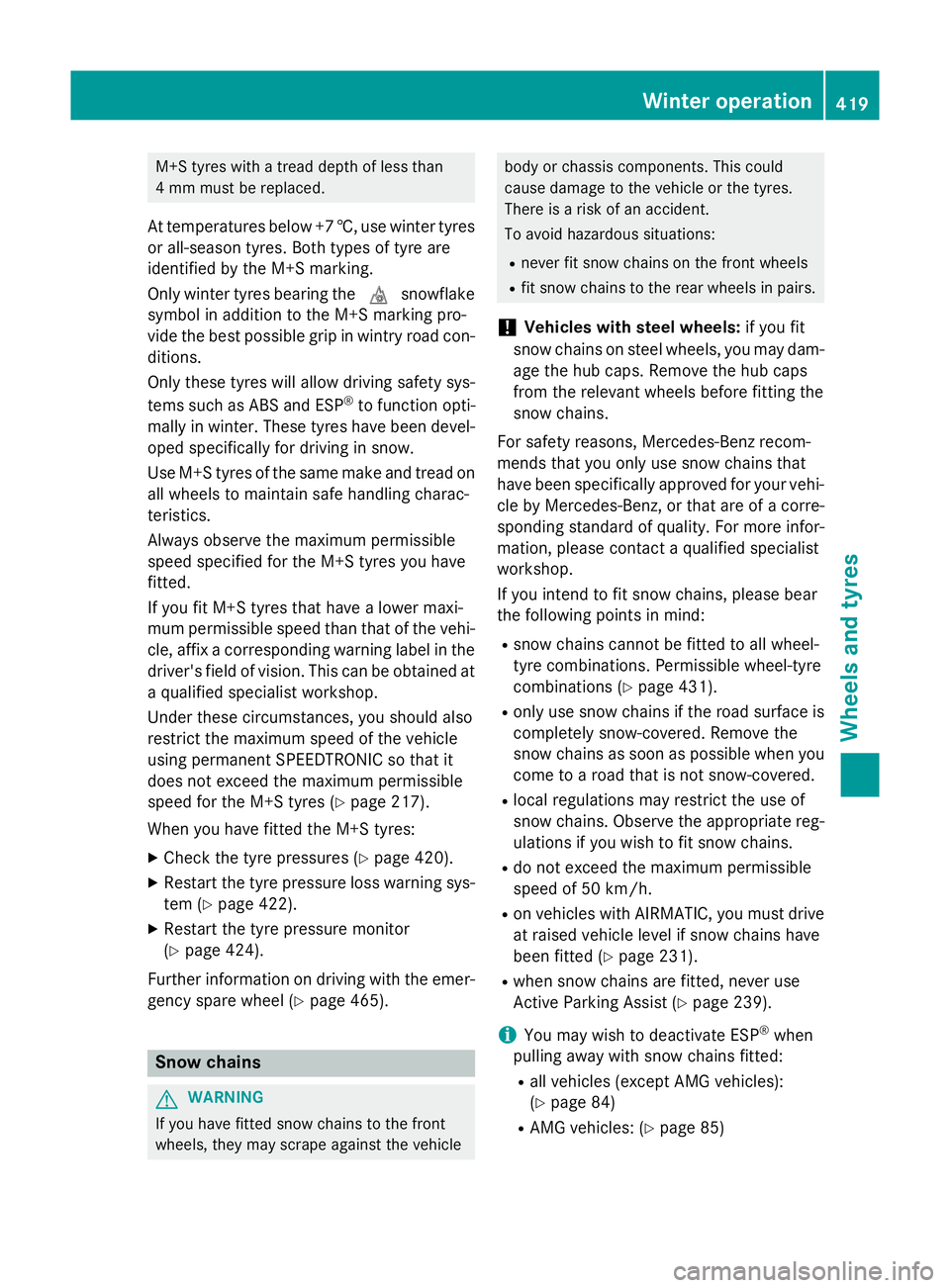
M+S tyres with
atread depth of less than
4m mm ust be replaced.
At temperatures below +7 †, use winter tyres or all-season tyres. Both types of tyre are
identified by the M+S marking.
Only winter tyres bearing the isnowflake
symbol in addition to the M+S marking pro-
vide the best possible grip in wintry road con- ditions.
Only these tyres will allow driving safety sys-
tems such as ABS and ESP ®
to function opti-
mally in winter. These tyres have been devel-
oped specifically for driving in snow.
Use M+S tyres of the same make and tread on all wheels to maintain safe handling charac-
teristics.
Always observe the maximum permissible
speed specified for the M+S tyres you have
fitted.
If you fit M+S tyres that have alower maxi-
mum permissible speed than that of the vehi-
cle, affix acorresponding warning label in the
driver's field of vision. This can be obtained at aq ualified specialist workshop.
Under these circumstances, you should also
restrict the maximum speed of the vehicle
using permanent SPEEDTRONIC so that it
does not exceed the maximum permissible
speed for the M+S tyres (Y page 217).
When you have fitted the M+S tyres:
X Check the tyre pressures (Y page 420).
X Restart the tyre pressure loss warning sys-
tem (Y page 422).
X Restart the tyre pressure monitor
(Y page 424).
Further information on driving with the emer-
gency spare wheel (Y page 465).Snow chains
G
WARNING
If you have fitted snow chains to the front
wheels, they may scrape against the vehicle body or chassis components. This could
cause damage to the vehicle or the tyres.
There is
arisk of an accident.
To avoid hazardous situations:
R never fit snow chains on the front wheels
R fit snow chains to the rear wheels in pairs.
! Vehicles with steel wheels:
if you fit
snow chains on steel wheels, you may dam-
age the hub caps. Remove the hub caps
from the relevant wheels before fittingt he
snow chains.
For safety reasons, Mercedes-Ben zrecom-
mends that you only use snow chains that
have been specifically approved for your vehi- cle by Mercedes-Benz, or that are of acorre-
sponding standard of quality. For more infor-
mation, please contact aqualified specialist
workshop.
If you intendtof it snow chains, please bear
the following points in mind:
R snow chains cannot be fitted to all wheel-
tyre combinations. Permissible wheel-tyre
combinations (Y page 431).
R only use snow chains if the road surface is
completely snow-covered. Remove the
snow chains as soon as possible when you
come to aroad that is not snow-covered.
R local regulations may restrict the use of
snow chains. Observe the appropriate reg-
ulations if you wish to fit snow chains.
R do not exceed the maximum permissible
speed of 50 km/h.
R on vehicles with AIRMATIC, you must drive
at raised vehicle level if snow chains have
been fitted (Y page 231).
R when snow chains are fitted, never use
Active Parking Assist (Y page 239).
i You may wish to deactivate ESP ®
when
pulling away with snow chains fitted:
R all vehicles (except AMG vehicles):
(Y page 84)
R AMG vehicles: (Y page 85) Winter operation
419Wheels and tyres Z
Page 423 of 497
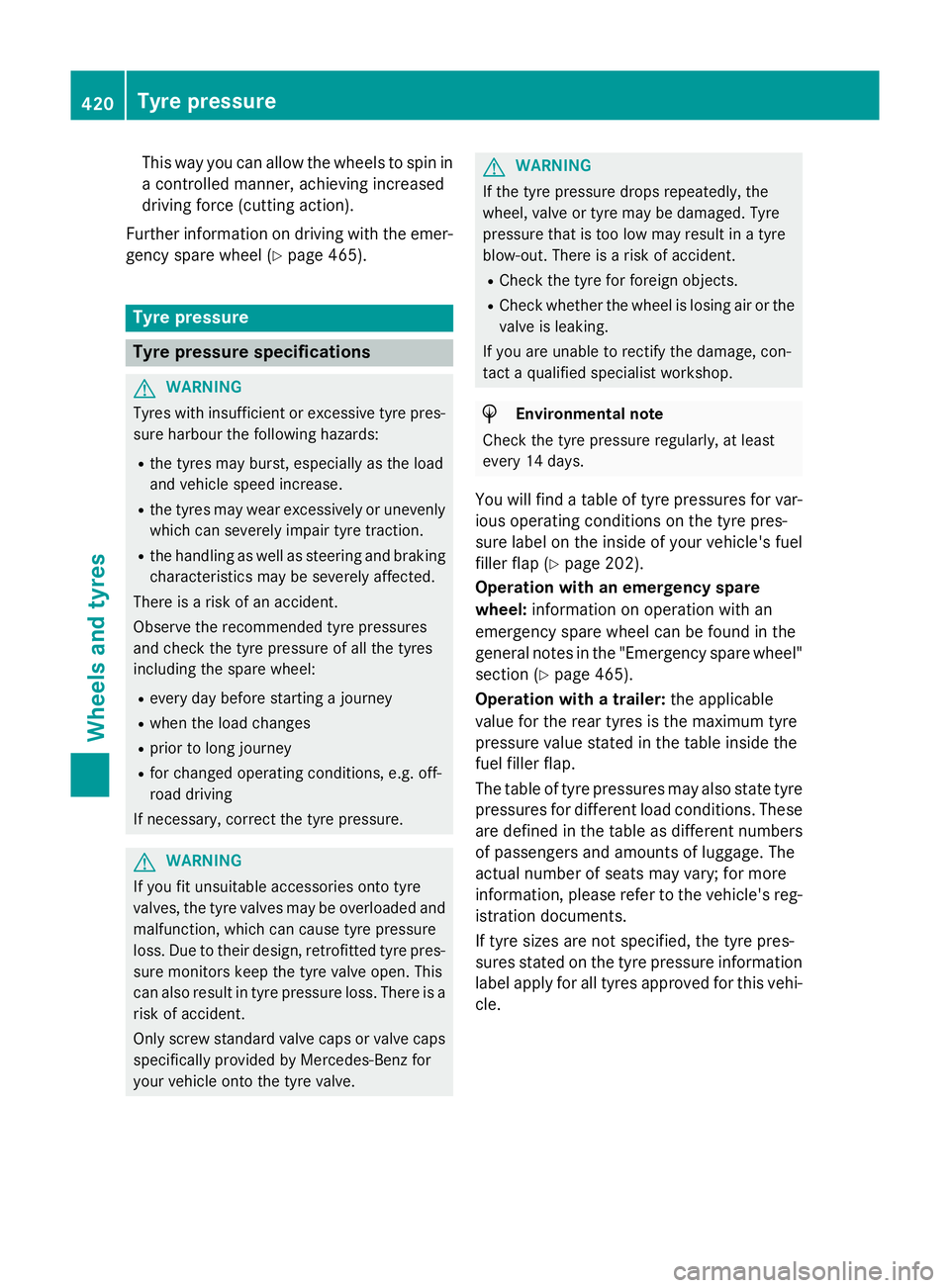
This way you can allow the wheels to spin in
ac ontrolled manner ,achieving increased
driving force (cutting action).
Further information on driving with the emer-
gency spare wheel (Y page 465).Tyrep
ressure Tyrep
ressure specifications G
WARNING
Tyres with insufficien torexcessiv etyre pres-
sure harbour the following hazards:
R the tyres may burst, especially as the load
and vehicle speed increase.
R the tyres may wear excessively or unevenly
which can severely impair tyre traction.
R the handling as well as steerin gand braking
characteristics may be severely affected.
There is arisk of an accident.
Observe the recommended tyre pressures
and check the tyre pressure of all the tyres
including the spare wheel:
R every day before starting ajourney
R when the load changes
R prior to long journey
R for changed operating conditions, e.g. off-
road driving
If necessary, correc tthe tyre pressure. G
WARNING
If you fit unsuitable accessories ontot yre
valves, the tyre valves may be overloaded and malfunction, which can cause tyre pressure
loss. Due to their design, retrofitted tyre pres-
sure monitors keep the tyre valve open. This
can also result in tyre pressure loss. There is a risk of accident.
Only screw standard valve caps or valve caps
specifically provided by Mercedes-Benz for
your vehicle ontot he tyre valve. G
WARNING
If the tyre pressure drops repeatedly, the
wheel, valve or tyre may be damaged. Tyre
pressure that is too low may result in atyre
blow-out. There is arisk of accident.
R Check the tyre for foreign objects.
R Check whether the wheel is losing air or the
valve is leaking.
If you are unable to rectify the damage, con-
tact aqualified specialist workshop. H
Environmenta
lnote
Check the tyre pressure regularly, at least
every 14 days.
You will find atable of tyre pressures for var-
ious operating conditions on the tyre pres-
sure label on the inside of your vehicle's fuel
filler flap (Y page 202).
Operation with an emergency spare
wheel: information on operation with an
emergenc yspare wheel can be found in the
general notes in the "Emergency spare wheel" section (Y page 465).
Operation with atrailer: the applicable
value for the rear tyres is the maximum tyre
pressure value stated in the table inside the
fuel filler flap.
The table of tyre pressures may also state tyre
pressures for different load conditions. These are defined in the table as different numbers
of passengers and amounts of luggage. The
actual number of seats may vary; for more
information, please refer to the vehicle's reg- istration documents.
If tyre sizes are not specified, the tyre pres-
sures stated on the tyre pressure information
label apply for all tyres approved for this vehi- cle. 420
Tyrep
ressureWheels and tyres
Page 424 of 497
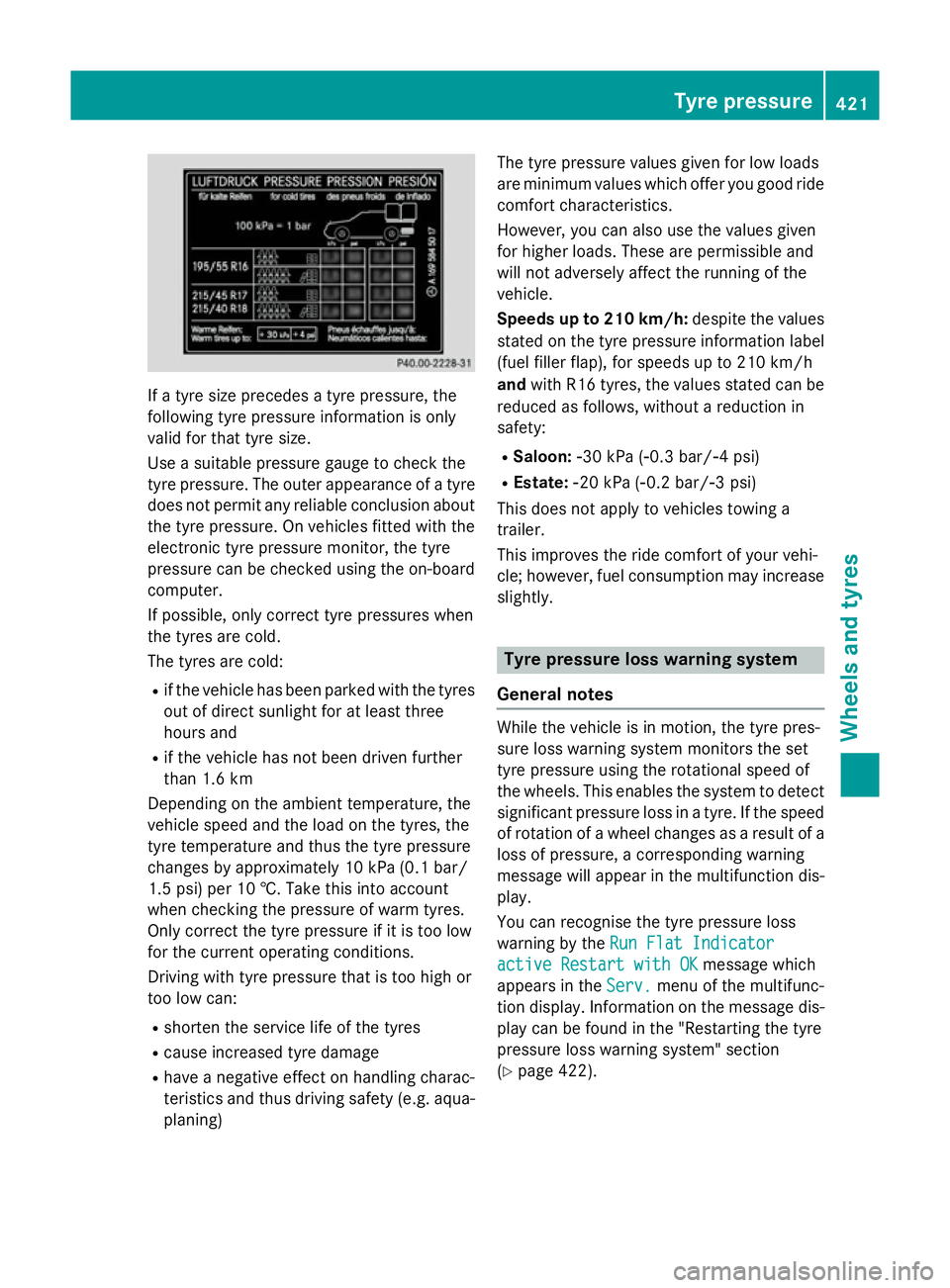
If
at yre size precedes atyre pressure, the
following tyre pressure information is only
validf or that tyre size.
Use asuitable pressure gauge to check the
tyre pressure. The outer appearance of atyre
does not permit any reliable conclusion about the tyre pressure. On vehicle sfitted with the
electronic tyre pressure monitor, the tyre
pressure can be checked using the on-board
computer.
If possible, only correct tyre pressures when
the tyres are cold.
The tyres are cold:
R if the vehicle has been parked with the tyres
out of direct sunlight for at least three
hours and
R if the vehicle has not been driven further
than 1.6 km
Depending on the ambient temperature ,the
vehicle speed and the loadont he tyres, the
tyre temperature and thus the tyre pressure
changes by approximately 10 kPa (0. 1bar/
1.5 psi )per 10 †. Take this into account
when checking the pressure of warm tyres.
Only correct the tyre pressure if it is too low
for the current operating conditions.
Driving with tyre pressure that is too high or
too low can:
R shorten the service life of the tyres
R cause increased tyre damage
R have anegative effect on handling charac-
teristics and thus driving safety (e.g. aqua-
planing) The tyre pressure values given for low loads
are minimum values which offer you good ride
comfort characteristics.
However, you can also use the values given
for higherl oads. These are permissible and
willn ot adversely affect the running of the
vehicle.
Speeds up to 210 km/h: despite the values
stated on the tyre pressure information label (fuel filler flap), for speedsupt o210 km/h
and with R16 tyres, the values stated can be
reduced as follows, withou tareduction in
safety:
R Saloon: Ò30 kPa (Ò0.3 bar/Ò4p si)
R Estate: Ò20 kPa (Ò0.2 bar/Ò3p si)
This does not apply to vehicle stowing a
trailer.
This improves the ride comfort of yourv ehi-
cle; however, fuel consumption may increase slightly. Tyre pressure lossw
arning system
General notes Whilet
he vehicle is in motion, the tyre pres-
sure loss warning system monitors the set
tyre pressure using the rotational speed of
the wheels. This enables the system to detect significant pressure loss in atyre. If the speed
of rotation of awhee lchanges as aresultofa
loss of pressure, acorresponding warning
messag ewilla ppear in the multifunction dis-
play.
You can recognise the tyre pressure loss
warning by the Run Flat Indicator Run Flat Indicator
active Restart with OK
active Restart with OK messagewhich
appears in the Serv.
Serv.menu of the multifunc-
tion display.I nformation on the messag edis-
playc an be found in the "Restarting the tyre
pressure loss warning system" section
(Y page 422). Tyre pressure
421Wheelsand tyres Z
Page 425 of 497
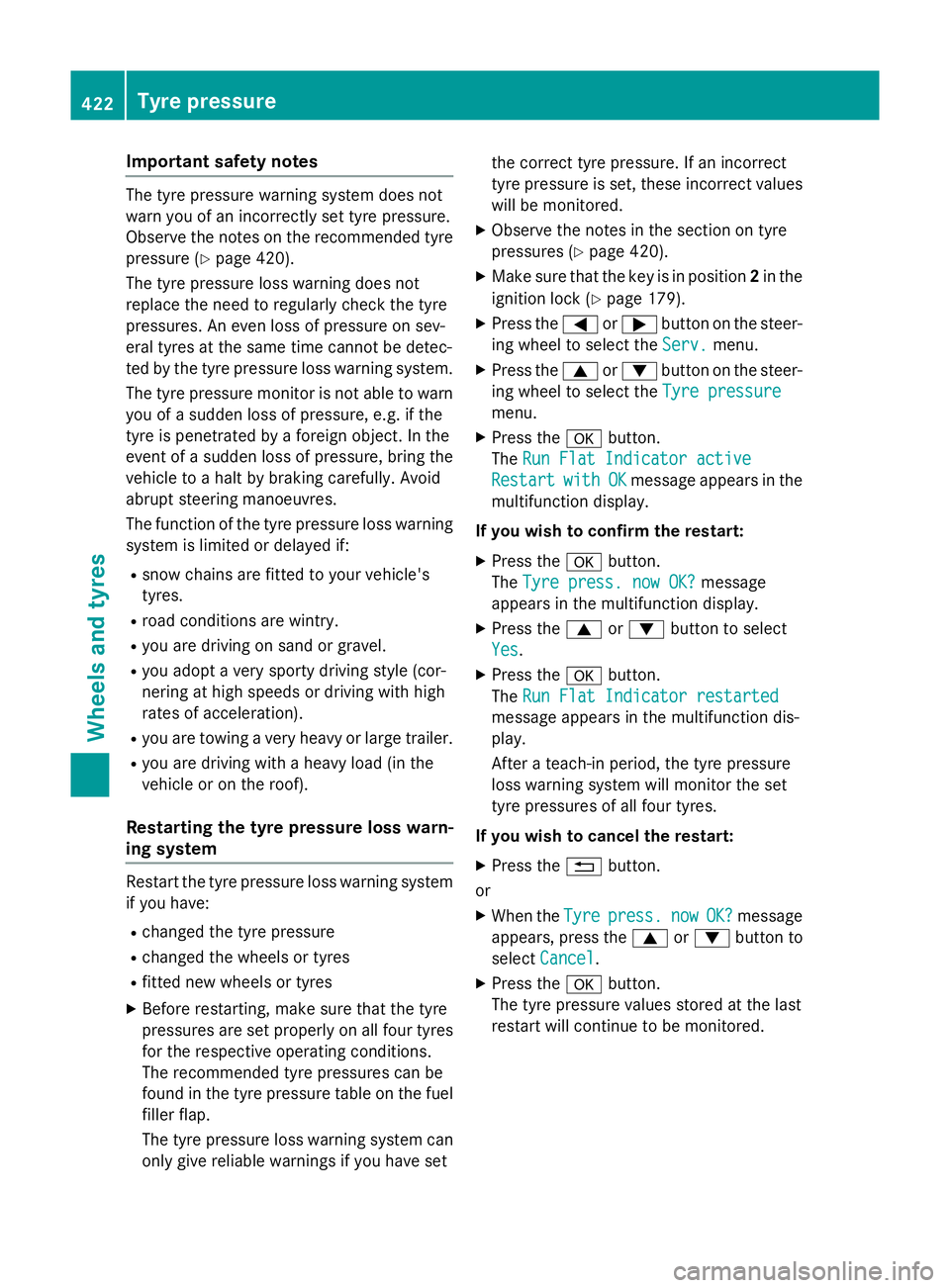
Important safety notes
The tyr
epressur ewarning system does not
warn you of an incorrectl yset tyr epressure.
Observ ethe note sont herecommended tyre
pressur e(Ypage 420).
The tyr epressur eloss warning does not
replace th eneedtor egularly chec kthe tyre
pressures. An eve nloss of pressur eonsev-
eral tyres at th esame time canno tbedetec-
te dbyt hetyrep ressur eloss warning system.
The tyr epressur emonitor is no table to warn
you of asudde nloss of pressure, e.g. if the
tyr eisp enetrated by aforeign object. In the
event of asudde nloss of pressure, brin gthe
vehicl etoah alt by braking carefully. Avoid
abrup tsteering manoeuvres.
The function of th etyrep ressur eloss warning
system is limited or delayed if:
R snow chains are fitte dtoyour vehicle's
tyres.
R road condition sare wintry.
R you are driving on san dorgravel.
R you adopt averys port ydriving style (cor-
nerin gath igh speeds or driving wit hhigh
rates of acceleration).
R you are towin gaveryh eav yorl argetrailer.
R you are driving wit haheavyload (in the
vehicl eoront heroof).
Restarting th etyrep ressure loss warn-
ing system Restart th
etyrep ressur eloss warning system
if you have:
R changed th etyrep ressure
R changed th ewheels or tyres
R fitte dnew wheels or tyres
X Befor erestarting ,makes ure that th etyre
pressures are set properly on all four tyres
for th erespective operating conditions.
The recommended tyr epressures can be
foun dint hetyrep ressur etable on th efuel
filler flap.
The tyr epressur eloss warning system can
only giv ereliable warning sifyou have set th
ec orrect tyrep ressure. If an incorrect
tyr ep ressur eisset,the se incorrec tvalues
will be monitored.
X Observ ethe note sint hesection on tyre
pressures (Y page 420).
X Mak esure that th ekeyis in position 2in the
ignition loc k(Ypage 179).
X Press the =or; buttononthesteer-
ing whee ltos elect the Serv.
Serv. menu.
X Press the 9or: buttononthesteer-
ing whee ltos elect the Tyrep ressure
Tyr ep ressure
menu.
X Press the abutton.
The Run Fla tIndicator active
Run Fla tIndicator active
Restart Restart with
withOK
OKmessage appear sinthe
multifunction display.
If you wish to confirm th erestart:
X Press the abutton.
The Tyrep ress. now OK?
Tyr ep ress. now OK? message
appear sinthemultifunction display.
X Press the 9or: buttontos elect
Yes
Yes .
X Press the abutton.
The Run Fla tIndicator restarted
Run Fla tIndicator restarted
message appear sinthemultifunction dis-
play.
Afte rateach-in period, th etyrep ressure
loss warning system will monitor th eset
tyr ep ressures of all four tyres.
If you wish to cance lthe restart:
X Press the %button.
or
X When the Tyre
Tyre press. press. now
now OK?
OK?message
appears, press the 9or: buttonto
select Cancel
Cancel .
X Press the abutton.
The tyr epressur evalue sstoredatt helast
restar twill continue to be monitored. 422
Tyre pressureWheels and ty
res
Page 426 of 497

Tyre pressure monitor
General notes If
at yrep ressure monitor system is fitted, the
vehicle's wheels have sensor sfitte dthat
monitor the tyr epressures in al lfou rtyres.
The tyr epressure monitor warns yo uifthe
pressure drops in one or mor eofthe tyres.
The tyr epressure monitor onl yfun ctions if
the corresponding sensor sarefitte dtoa ll
wheels.
Informatio nontyrep ressures is shown in the
multifunctio ndisplay .After afew minute sof
driving ,the current tyr epressure of each tyre
is shown in the Service
Service menu of the multi-
functio ndisplay ,see illustratio n(example). Example: Saloon
,current tyr epressure display
For furthe rinformatio nondisplaying this
message ,refer to the "Checking the tyr epres-
sure electronically" sectio n(Ypage 424).
Important safety notes It is the driver's responsibility to set the tyre
pressure to the recommende
dcoldt yrep res-
sure suitabl efor the operating situation
(Y page 420). Note tha tthe correct tyr epres-
sure for the current operating situatio nmust
first be taught-i ntothe tyr epressure monitor.
If ther eisas ubstantial loss of pressure, the
warnin gthreshold for the warnin gmessage is
aligned to the reference values taught-in.
Restart the tyr epressure monitor after
adjusting to the col dtyrep ressure
(Y page 424). The current pressures are
saved as new reference values. Thi swill
ensur ethataw arnin gm essage will only
appear if the tyr epressure drops significantly.
The tyr epressure monitor does not warn you
of an incorrectly set tyr epressure. Observe the note
sonthe recommende dtyrep ressure
(Y page 420).
The tyr epressure monitor is not able to warn
yo uofas uddenlossofp ressure, e.g .ifthe
tyr eisp enetrated by aforeign object. In the
event of asudde nlossofp ressure, bring the
vehicl etoah altbyb raking carefully. Avoid
abrupt steering manoeuvres.
The tyr epressure monitor ha sayelloww arn-
ing lamp in the instrument cluster for indicat- ing apressure loss or malfunction. Depending
on how the warning lamp flashe sorlights up,
at yrep ressure tha tist oo lo woram alfunc-
tio nint he tyr epressure monitor is indicated:
R if the warnin glam pisl itcontinuously ,the
tyr ep ressure on one or mor etyres is sig-
nificantl ytoo low. The tyr epressure moni-
tor is not malfunctioning.
R if the warnin glam pflashe sfor around a
minute and the nremains li tconstantly, the
tyr ep ressure monitor is malfunctioning.
In additio ntothe warning lamp, amessage
appear sinthe multifunctio ndisplay .Obser ve
the informatio nondisplay messages
(Y page 322).
It ma ytake up to ten minute sfor am alfunc-
tio noft he tyr epressure monitor to be indi-
cated. Amalfunctio nwillbei ndicated by the
tyr ep ressure warnin glam pflashing for
approximately one minute and the nremain-
ing lit. When the faul thas been rectified, the
tyr ep ressure warning lamp goes ou tafter you
have driven for afew minutes.
The tyr epressure values indicated by the on-
boar dcompute rmaydiffe rfromt hos em eas-
ured at afilling statio nusing apressure
gauge. The tyr epressures shown by the on-
boar dcompute rrefer to thos emeasured at
se al evel.Ath igha ltitudes, the tyr epressure
values indicated by apressure gaug eare
highe rtha nt hos eshown by the on-board
computer. In thi scase, do not reduce the tyre
pressures.
The operatio nofthe tyr epressure monitor
can be affecte dbyinterference fro mradio
transmitting equipment (e.g. radi ohead- Tyre pressure
423Wheelsand tyres Z